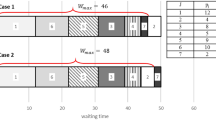Abstract
This paper attempts to compare the performance between a single-stage appointment scheduling system and two-stage appointment scheduling system. For this purpose, a queuing model is firstly formulated with the objective of maximizing the weighted hospitals benefit minus the cost of patient waiting and doctor overtime, for a two-stage appointment scheduling system considering no-shows. To facilitate the comparison, we can alter the number of diagnosis stages by adjusting the probabilities that patients need to do further examinations, e.g., X-rays or blood tests. The single-stage queuing model assumes that all patients will finish their treatment after their first diagnosis, and other assumptions are the same as that in a two-stage appointment scheduling system. The performances of two-stage appointment scheduling systems varying with no-show probabilities and probabilities that patients have a second-stage diagnosis are presented. Experimental results indicate that the optimal number of patients needs to be more than the capacity of doctors in the first few slots, and less than those in the last few slots. We need to weigh the probability of no-shows and the probability of doing further examinations (second-stage) when determining the total number of patients to be scheduled. Under a higher no-show probability, arranging more patients than the workload reduces the waste of doctors capacity; and on the contrary, under a higher probability of doing examinations, arranging fewer patients than the workload can reduce system congestion.









Similar content being viewed by others
References
Ahmadi-Javid A, Jalali Z, Klassen KJ (2016) Outpatient appointment systems in healthcare : a review of optimization studies. Eur J Oper Res 258(1):3–34
Bailey N (1952) A study of queues and appointment systems in hospital out-patient departments with special reference to waiting-times. J R Stat Soc B 14(2):185–199
Castro E, Petrovic S (2012a) Combined mathematical programming and heuristics for a radiotherapy pre-treatment. J Sched 15(3):333–346 scheduling problem
Castro E, Petrovic S (2012b) Combined mathematical programming and heuristics for a radiotherapy pre-treatment scheduling problem. J Sched 15(3):333–346
Cayirli T, Veral E (2003) Outpatient scheduling in health care : a review of literature. Prod Oper Manag 12(4):519–549
Conforti D, Guerriero F, Guido R (2008) Optimization models for radiotherapy patient scheduling. 4OR-Q J Oper Res 6(3):263–278
Conforti D, Guerriero F, Guido R (2010) Non-block scheduling with priority for radiotherapy treatments. Eur J Oper Res 201(1):289–296
Conforti D, Guerriero F, Guido R, Veltri M (2011) An optimal decision-making approach for the management of radiotherapy patients. OR Spektrum 33(1):123–148
Gupta D, Denton B (2008) Appointment scheduling in health care: challenges and opportunities. IIE Trans 40:800–819
Hulshof PJH, Kortbeek N, Boucherie RJ, Hans EW, Bakker PJM (2012) Taxonomic classification of planning decisions in health care: a structured review of the state of the art in or/ms. Health Syst 1(2):129–175
Kaandorp G, Koole G (2007) Optimal outpatient appointment scheduling. Health Care Manag Sci 10:217–229
Kemper B, Klaassen CA, Mandjes M (2014) Optimized appointment scheduling. Eur J Oper Res 239(1):243–255
Kuiper A, Kemper B, Mandjes M (2015) A computational approachto optimized appointment scheduling. Queueing Syst 79(1):5–36
Laganga LR, Lawrence SR (2007) Clinic overbooking to improve patient access and increase provider productivity. Decis Sci 38(2):251–276
LaGanga LR, Lawrence SR (2012) Appointment overbooking in health care clinics to improve patient service and clinic performance. Prod Oper Manag Soc 21(5):847–888
Lambrecht SM (2009) An advanced queueing model to analyze appointment-driven service systems. Comput Oper Res 36(10):2773–2785
Lin J, Muthuraman K, Lawley M (2011) Optimal and approximate algorithms for sequential clinical scheduling with no-shows. IIE Trans Healthc Syst Eng 1(1):20–36
Liu N, Ziya S (2015) Panel size and overbooking decisions for appointment-based services under patients no-shows. Prod Oper Manag 23(12):2209–2223
Osorio C, Bierlaire M (2009) An analytic finite capacity queueing network model capturing the propagation of congestion and blocking. Eur J Oper Res 196(3):9966–1007
Prez E, Ntaimo L, Wilhelm WE, Bailey C, McCormack P (2011) Patient and resource scheduling of multi-step medical procedures in nuclear medicine. IIE Trans Healthc Syst Eng 1(3):168–184
Prez E, Ntaimo L, Malav CO, Bailey C, McCormack P (2013) Stochastic online appointment scheduling of multi-step sequential procedures in nuclear medicine. Health Care Manag Sci 16(4):281–299
Rais A, Viana A (2010) Operations research in healthcare: a survey. Int Trans Oper Res 18:1–31
Robinson LW, Chen RR (2010) A comparison of traditional and open-access policies for appointment scheduling. Manuf Serv Oper Manag 12:330–346
Samorani M, LaGanga LR (2015) Outpatient appointment scheduling given individual day-dependent no-show predictions eur. J Oper Res 240(1):245–257
Turkcan A, Zeng B, Lawley M (2012) Chemotherapy operations planning and scheduling. IIE Trans Healthc Syst Eng 2(1):31–49
Vissers J (2011) Or in healthcare: a European perspective. Eur J Oper Res 212(2):223–234
Wang J, Fung RY (2014) An integer programming formulation for outpatient scheduling with patient preference. Ind Eng Manag Syst 13(2):193–202
Wang WY, Gupta D (2011) Adaptive appointment systems with patient preferences. Manuf Serv Oper Manag 13(3):373–389
Wolsey GNL (2014) Integer and optimization. In: Integer and optimization. Wiley
Yan C, Tang J, Jiang B, Fung RY (2015) Comparison of traditional and open-access appointment scheduling for exponentially distributed service time. J Healthc Eng 6(3):345
Zeng B, Turkcan A, Lin J, Lawley M (2010) Clinic scheduling models with overbooking for patients with heterogeneous no-show probabilities. Ann Oper Res 178(1):121–144
Acknowledgements
This paper is financially supported by National Natural Science Foundation of China (71420107028, 71501027).
Author information
Authors and Affiliations
Corresponding author
Additional information
Publisher's Note
Springer Nature remains neutral with regard to jurisdictional claims in published maps and institutional affiliations.
Rights and permissions
About this article
Cite this article
Fan, X., Tang, J. & Yan, C. Appointment scheduling optimization with two stages diagnosis for clinic outpatient. Comput Stat 35, 469–490 (2020). https://doi.org/10.1007/s00180-019-00876-0
Received:
Accepted:
Published:
Issue Date:
DOI: https://doi.org/10.1007/s00180-019-00876-0




